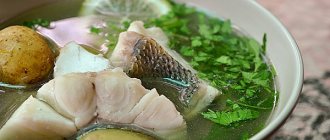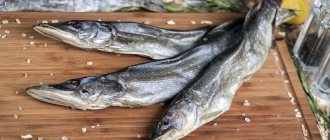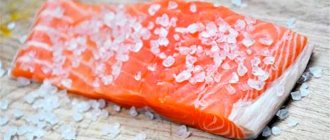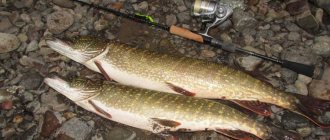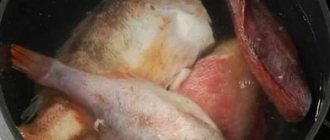Dried fish is sold in many retail outlets, but to be sure of the quality of the product, it is best to make it yourself. To dry fish at home you don’t need to have any special skills; even a beginner can handle this simple process.
The taste of the finished product will depend not only on the cooking process. The quality of the finished product is affected by the size of the fish, fat content and fiber structure.
It is worth taking into account that drying is the process of drying fish carcasses with preliminary salting, which is mandatory for this method of preparation.
How long and how to soak fish after salting
With the question “How to soak fish after salting?”
encountered relatively recently. The time has ended when water from the Angara could be drunk without any fear and the caught fish was purposefully salted with a small amount of salt so as not to spoil the taste. Lightly salted spruce, grayling, tugunok, whitefish and pike - you can already forget about it. With a dam erected in the form of the Boguchansky reservoir, the danger of infection by parasites forces the use of steep brines when salting. And, as a result, an additional stage arises - soaking the fish. For drying, smoking or just eating it “raw” - there is no difference. So far this applies, in my case, only to river fish. Maybe I’m wrong, but the percentage of catching “smaller brothers” from store-bought red fish, willow fish or mackerel is small.
At first, I became interested in the Internet on forums. They told us how to soak fish in milk and vinegar. I tried it. Neptune knows him, maybe the milk is not the same, maybe only a certain type of fish can be combined with it, but not the same taste, for the life of me. I’m generally silent about vinegar. Herring with onions and vinegar on the table is a wonderful appetizer, but it doesn’t work with sorog, dace or perch. I wouldn’t want to seem picky, but for a native Angarian... it’s creepy.
I settled on the simplest and, as it turned out, effective method - soaking in water and periodically replacing it completely. For you who are faced with this issue for the first time, I’ll tell you straight - don’t expect that you will get what you want the first time. The taste and color...you understand. You will have to go through this procedure two or three times until you get fish with the required salt content that suits your taste.
Drying fish using household appliances
The best method of drying is considered to be drying in the open air. But you can properly dry fish at home in an oven, electric dryer, or drying cabinet. Such methods are suitable for small and medium-sized carcasses.
In the oven
The fish are dried at a temperature of 150-180 degrees in the oven. Then they wrap their heads in foil and leave them for another couple of hours. Then, for final readiness, they are hung on the balcony.
In an electric dryer
Place the carcasses on trays or electric dryer racks and turn on medium heat. Periodically, the electric dryer is turned off to prevent the delicacy from overdrying.
Drying stages
Let's start drying fish: salting recipes
Dry
The fish (usually large ones) are placed in a wooden or plastic box covered with cloth in layers, belly up. You can also use a basket or even a clean bag (jute or plastic). It is important that the container has holes through which the juice released from the fish will flow out. The raw materials are sprinkled with salt on all sides (the heads need to be treated especially carefully). For 10 kg of fish take at least 1.5 kg of salt. Cover the container with a flat lid, put pressure (for example, a three- or five-liter jar of water) and put it in a cool place. Salting usually takes from 5 to 10 days.
Tuzluchny
The fish, tightly placed in a basin or pan with their tummies up, is sprinkled with salt in layers (1 kg per 10 kg of raw material) and pressed under pressure. In this case, the brine (brine) that is released from the fish remains in the container. After 1-2 days it rises above the raw material. After this, the container is left in a cool place until the fish is salted, that is, at least another day for small ones and a week for large specimens.
Wet
The fish, prepared and placed in a container, is poured with a cold solution prepared from coarse salt and water (about 350 g per 1 liter). The suitability of the brine can be checked: a fresh egg immersed in liquid should remain on the surface. Small fish are kept in a salt solution for 2-3 days, and large fish for about a week. After the product is removed from the brine, it must lie in the air for 1-2 hours so that the salt is evenly distributed throughout the tissues.
"Spring"
As a variant of wet salting, the so-called hanging salting is used. In this case, small fish are strung on rods, a cord or fishing line through the eye holes and lowered into the brine so that they do not press on each other. In medium-sized (non-gutted) specimens, the abdominal cavity is filled in advance with a strong salt solution, pumping it through the mouth opening using a syringe so that the flesh is salted out more reliably and evenly.
In addition, there are varieties of dry and brine salting , in which sugar, dill or spices (ground pepper, bay leaf, coriander and even cinnamon) are added to the salt with which the fish is sprinkled. If you dry fish processed in these ways, you will get products that are distinguished by a particularly refined, “spicy” or “balyk” taste.
The readiness of the fish for the next stage is determined as follows: the carcass is taken by the head and tail and stretched in the longitudinal direction. In a well-salted fish, the spine “crunches”, producing a specific sound. You can press your finger on the back of the fish: if salted correctly, there will be a hole left on it.
Soaking the fish
Before you dry the fish, you need to soak it. This is done in order to remove salt from the subcutaneous layer of pulp. If you skip this step, your skin will not dry properly. In this case, the surface of the finished product will become damp, and the fish simply cannot be stored.
The easiest way is to soak the raw materials under the tap, while simultaneously washing it from any remaining mucus. The washed fish are placed in a bowl of cold water. If they do not sink, it means that the pulp already contains the optimal amount of salt for drying. The total period of washing and soaking should not exceed 1 hour for every day of preliminary salting. Large, fatty fish should not be kept in water continuously for 7-10 hours, so as not to reduce the taste of the final product. Every 2-3 hours it is taken out and kept in the air for some time, and then soaking continues.
We bring to your attention a video in which a fisherman talks about how he soaks fish.
Drying (at what temperature to dry fish)
The fermentation that fish tissue undergoes during drying occurs in the absence of heat treatment. That is why the final stage (drying of salted raw materials) should take place at a temperature no higher than 18-20 ℃ and constant ventilation. It is best to do this in spring or autumn. In this case, the fish does not overheat in the sun.
To protect against flies that can spoil the product, a variety of means are used: the fish is covered with gauze, sprayed with vinegar, sometimes even coated with a mixture of vinegar and vegetable oil. Experienced fishermen hang out their catch to dry in the evening. At this time, there are almost no flies, and during the night the surface layer of the raw material hardens, and insects can no longer damage it.
The final stage of drying (drying salted fish) should take place at a temperature no higher than 18-20 ℃ and constant ventilation
You can dry fish in winter. Connoisseurs appreciate the product obtained by freezing moisture. At temperatures close to 0 ℃, fish takes a long time to dry, and its taste differs from that typical for spring, summer and autumn catch.
This is how they dry fish in Norway
